
Libraries
Libraries
Preciosa margarita de la vida y muerte y gloria de la serenísima Virgen María, madre de Dios
The extensive and careful volume composed by limeño Diego Flores reveals the complex administrative, cultural and commercial dimension of the Viceroyalty of Peru. Flores, its erudite and polished author born in Los Reyes de Lima, was -as he declares in his dedication to Felipe III- one of the first students of the Universidad Real de Lima (now Universidad Nacional Mayor de San Marcos). The printing of the book was a distinguished neighbor of Villa de la Plata (current Chuquisaca) in the Royal Audience of Charcas. As stated on the cover, he held the positions of vicar of the nuns and administrator of the Royal Hospital, as well as professor of Divine Letters.
Although La Plata held the rank of city since 1555 (by Royal Decree of Carlos V), it was at the beginning of the seventeenth century when it was in the mouth of the other citizens of the Kingdoms of Peru, since Pope Paul V created the dioceses of La Paz y de Santa Cruz (1605) and, four years later, he decreed that the Archdiocese of La Plata de los Charcas be erected, which was in charge of the dioceses of Asunción, Tucumán, La Paz and Santa Cruz de la Sierra. Thus, the volume Preciosa margarita evidences the intellectual, artistic and devout activity of the early La Plata Creole community.
It is a long form that involved a great investment of time and money. Thus, together with distinguished members of the La Plata community, Francisco del Canto himself dedicates a poem to the author and to his work in the preliminaries. It is a valuable example of sacred literature related to the extensive tradition of the vitae Mariae, so fruitful in the Hispanic world. Although the lives of Mary, on Hispanic soil, appear alternately throughout the seventeenth century, it is common to find them in the epic mold of the royal octaves and, in most cases, linked to other matters -such as the life of Christ itself. – or presented by one of its edges: such is the case of the defense of the Immaculate Conception of Mary.
Preciosa margarita is a unique book that, through a successful prosymmetric composition, summarizes the life of the Virgin Mary from biblical and patristic sources. It is close to hagiographic literature to the extent that – as Flores maintains in his prologue to the Christian reader – the volume operates as a kind of mirror of life and is added to the sacred letters: it is edifying and exemplary. Although the author emphasizes his crude style, the metric translations that he makes of various passages of sacred texts (both from the Bible and from sermons and other minor genres) from various Church authorities are a clear demonstration of his literary talent. Sonnets, royal octaves and other compositions abound that serve as boxes to contain his translations as well as his own inventions.
A separate comment deserves the typesetting of the volume, due to its importance for the literate culture and for Marian iconography. The same sonnet by the printer Francisco del Canto dedicated to the author and his work reveals the importance of print as a publishing project. Its costly invoice corresponds to the complex nature of the book that, on the one hand, confirms the importance of Marian devotions at the beginning of the 17th century and, on the other, to the discursive strategies of the first Creoles to legitimize their position within the intricate social system. of Hispanic modernity.
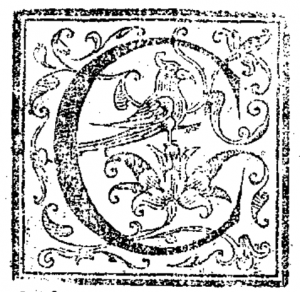
Capital letter with animal and vegetal motifs
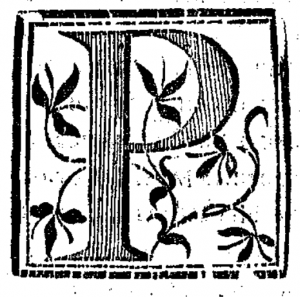
Capital letter with vegetal motif

Example of folio with comment, ribbon and drop cap letter
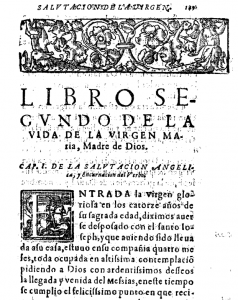
Second book portico
The volume has a careful typographic composition capable of showing off its prosymmetrical nature: the poems interspersed between the prose passages are duly highlighted by the arrangement of the letters, as well as by decorative elements. However, the most important, in my opinion, is the series of marginal annotations, the columns of which reveal the author’s special interest in pointing out the source of his scholarship. Both the citations of the sacred texts and the passages that have been translated or paraphrased are recorded. Thus, the same selection of sources used testifies to the knowledge about the transcendent, about the spiritual and, of course, about the importance of the Marian cult for the evangelization of the seventeenth century. Preciosa margarita is a testimony of both the devotion to the Virgin and the bibliography that built the American orthodoxy of the cult of the mother of God.
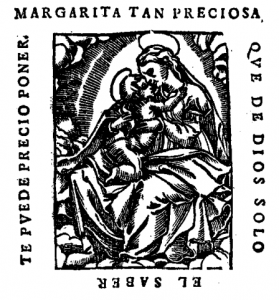
Engraving of the Virgin and Child
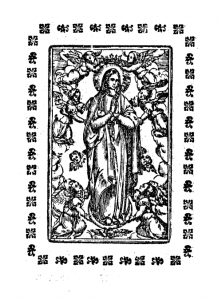
Coronation of the Virgin
Diego Flores’s book is an important source for the study of the consolidation of Marian iconography. In the print, there are two images of the Virgin that complete the image of the Marian canvas painted by the evangelizers on American soil. Fifty-seven years had elapsed since the printing of the woodcut of the Virgin Mary in Doctrina Christiana en Lengua Mexicana (1553) and that of Preciosa margarita (1610/1611). Just five years later, the famous engraving made by Samuel Stradanus on Los milagros realizados por la virgen de Guadalupe (1615) was printed. While a detailed study of the engravings contained in Flores’ work is required, there are obvious signs linking them to early Germanic iconography with accents of Italian Mannerism.
Elio Vélez Marquina
Departamento Académico de Humanidades
Universidad del Pacífico

